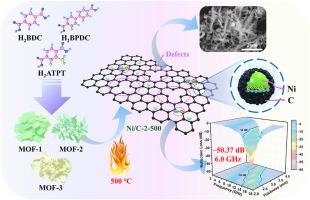Ni- mof材料制备的高性能电磁吸波Ni/C复合材料:有机配体和热解温度的影响
IF 11.6
2区 材料科学
Q1 CHEMISTRY, PHYSICAL
引用次数: 0
摘要
镍有机骨架(Ni-MOF)衍生的磁性碳基材料被认为是一种极具潜力和应用价值的电磁波吸收材料。然而,ni - mof衍生的磁性碳基材料的精确设计仍然是一个巨大的挑战。在本工作中,通过有机配体和热解温度的调制,获得了具有优异电磁吸收性能的Ni/C复合材料,其多重损耗得到改善,阻抗匹配得到优化。具体来说,有机配体和热解温度会影响碳骨架的石墨化程度和Ni/C复合材料的比表面积,从而改变其电导率、磁性能和电磁参数。特别是,以H2BPDC为有机配体,在500℃下煅烧的Ni/C-2-500样品,在填充率为30 wt%,厚度为2.5 mm时,RLmin为−50.37 dB, EAB为6.0 GHz,覆盖了整个Ku波段。此外,Ni/C-2-500还具有良好的导热性。因此,本研究为探索不同有机配体制备的具有可调谐EMW吸收性能和热传导优势的MOF材料及其衍生物提供了思路。本文章由计算机程序翻译,如有差异,请以英文原文为准。

High-performance electromagnetic absorbing Ni/C composites derived from Ni-MOF materials: Effects of organic ligands and pyrolysis temperatures
Magnetic carbon-based materials derived from nickel organic framework (Ni-MOF) are considered to be a kind of electromagnetic wave (EMW) absorbing materials with great potential and application value. However, the precise design of Ni-MOF-derived magnetic carbon-based materials remains a huge challenge. In the present work, through the modulation of organic ligand and pyrolysis temperature, Ni/C composites with excellent electromagnetic absorption properties are obtained due to their improved multiple loss and optimized impedance matching. Specifically, the organic ligand and pyrolysis temperature affect the degree of graphitization of the carbon frame and the specific surface area of the Ni/C composites, thus changing the conductivity, magnetic properties and electromagnetic parameters. In particular, the sample Ni/C-2-500 using H2BPDC as the organic ligand and calcined at 500 °C gives an RLmin of −50.37 dB and an EAB of 6.0 GHz at a packing rate of 30 wt% and a thickness of 2.5 mm, which covers the entire Ku band. In addition, Ni/C-2-500 exhibits good thermal conductivity. Therefore, this study provides an idea for exploring MOF materials and their derivatives with tunable EMW absorbing properties and heat conduction advantages prepared by different organic ligands.
求助全文
通过发布文献求助,成功后即可免费获取论文全文。
去求助
来源期刊

Carbon
工程技术-材料科学:综合
CiteScore
20.80
自引率
7.30%
发文量
0
审稿时长
23 days
期刊介绍:
The journal Carbon is an international multidisciplinary forum for communicating scientific advances in the field of carbon materials. It reports new findings related to the formation, structure, properties, behaviors, and technological applications of carbons. Carbons are a broad class of ordered or disordered solid phases composed primarily of elemental carbon, including but not limited to carbon black, carbon fibers and filaments, carbon nanotubes, diamond and diamond-like carbon, fullerenes, glassy carbon, graphite, graphene, graphene-oxide, porous carbons, pyrolytic carbon, and other sp2 and non-sp2 hybridized carbon systems. Carbon is the companion title to the open access journal Carbon Trends. Relevant application areas for carbon materials include biology and medicine, catalysis, electronic, optoelectronic, spintronic, high-frequency, and photonic devices, energy storage and conversion systems, environmental applications and water treatment, smart materials and systems, and structural and thermal applications.
 求助内容:
求助内容: 应助结果提醒方式:
应助结果提醒方式:


